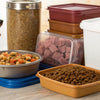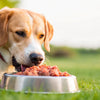How Much Raw Food to Feed My Dog: A Comprehensive Guide for Pet Owners
- Houndsy
Table of Contents
- Introduction
- Understanding Your Dog's Nutritional Needs
- Recommended Feeding Amounts for Adult Dogs
- Recommended Feeding Amounts for Puppies
- Transitioning to a Raw Diet
- Benefits of Feeding Raw Food
- The Role of the Houndsy Kibble Dispenser
- Conclusion
Introduction
Imagine coming home after a long day, only to find your dog's bowl empty, and a sense of guilt washes over you. Did you give them enough to eat today? Are they getting the nutrition they need? As pet parents, we all want to provide the best for our furry friends, and knowing how much raw food to feed our dogs is vital for their overall health and well-being.
Did you know that the dietary needs of dogs can vary dramatically based on their age, weight, metabolism, and even the weather? This complexity often leaves many pet owners confused about proper feeding practices, leading to over or underfeeding. But don’t worry! By the end of this blog post, you will have a clear understanding of how much raw food to feed your dog, tailored to meet their unique needs.
We’ll cover essential factors affecting your dog’s diet, recommended feeding guidelines for different ages and weights, and tips for transitioning your pup to a raw diet without hassle. We’ll also share insights on why the Houndsy Kibble Dispenser can simplify your feeding routine, ensuring every meal is convenient and consistent while being visually appealing in your home décor.
So, grab a cup of coffee, take a seat, and let’s dive into the world of raw dog food feeding.
Understanding Your Dog's Nutritional Needs
Factors Influencing Feeding Amounts
Before we can answer the question of how much raw food to feed your dog, we must first consider the various factors that influence their nutritional needs:
-
Body Weight: The amount of food largely depends on your dog's weight. Larger dogs require more food than smaller breeds, but they also generally get fed a lower percentage of their body weight.
-
Age: Puppies have different dietary needs compared to adult dogs. They tend to need more food because they are growing and developing, while senior dogs might require fewer calories to maintain a healthy weight.
-
Activity Level: An active dog will burn more calories than an inactive one. If your dog is a working dog or participates in regular exercise, they will need an increased caloric intake.
-
Metabolic Rate: Each dog metabolizes food differently. Some breeds may have naturally faster metabolisms, requiring them to eat more to maintain their energy levels.
-
Health Conditions: Any health issues should also be taken into consideration. Dogs with specific health conditions may have tailored dietary requirements as advised by a veterinarian.
By understanding these factors, you can begin to tailor the raw food feeding guidelines accordingly to ensure your dog stays healthy and happy.
The Standard Guidelines for Raw Dog Food
The general recommendation for raw food feeding is expressed as a percentage of your dog's body weight. Here's a straightforward breakdown:
- Adult Dogs: Feed them 2-3% of their ideal body weight daily.
- Puppies: Puppies are more energetic and growing, hence they need more—4-6% of their current weight daily.
Let’s dive deeper into each group's specific portion sizes.
Recommended Feeding Amounts for Adult Dogs
Feeding adult dogs can be simplified by using their body weight as a baseline measurement. Here’s how it breaks down:
Feeding Chart for Adult Dogs
| Dog Weight | 2% of Body Weight | 2.5% of Body Weight | 3% of Body Weight |
|---|---|---|---|
| 10 lbs | 0.2 lbs (~3.2 oz) | 0.25 lbs (~4 oz) | 0.3 lbs (~4.8 oz) |
| 25 lbs | 0.5 lbs (~8 oz) | 0.625 lbs (~10 oz) | 0.75 lbs (~12 oz) |
| 50 lbs | 1 lb (~16 oz) | 1.25 lbs (~20 oz) | 1.5 lbs (~24 oz) |
| 75 lbs | 1.5 lbs (~24 oz) | 1.875 lbs (~30 oz) | 2.25 lbs (~36 oz) |
| 100 lbs | 2 lbs (~32 oz) | 2.5 lbs (~40 oz) | 3 lbs (~48 oz) |
These are general recommendations, so make sure to monitor your dog closely. If your pooch is becoming underweight or showing signs of excess energy, you may want to adjust their food amounts upwards. Conversely, if they seem overweight or lethargic, reducing their intake is wise.
Example Calculation
Say you have a 50-pound dog. According to the chart, at the 2% feeding rate, your dog would need 1 pound of food per day. If you choose to feed at 2.5%, it would be 1.25 pounds, and at 3%, it would be 1.5 pounds daily.
By knowing your dog’s current weight, you can easily find the range that works best.
Recommended Feeding Amounts for Puppies
Feeding puppies is a bit different. They require more food relative to their body weight to support their growth and energy needs.
Feeding Guidelines for Puppies
- For puppies aged 3 to 12 weeks: 4-6% of their current body weight.
- Once they reach about 12 weeks, gradually reduce it to 2-3% as they transition into adulthood.
Say you have a 10-pound puppy; you should start at approximately 0.4 to 0.6 pounds (6.4 to 9.6 ounces) daily. Monitoring body condition and adjusting portions accordingly is essential since puppies can grow rapidly.
Feeding Schedule
Puppies should be fed more frequently than adults—ideally three to four times a day until they reach 6 months old. After that, you can transition them to two meals daily, aligning more with an adult's feeding schedule.
Transitioning to a Raw Diet
Transitioning your dog from kibble or canned food to a raw diet requires care to prevent digestive upset. Here’s how to do it smoothly:
Step-by-Step Transition Guide
- Start Slow: For the first week, start by mixing ¼ of the new raw diet with ¾ of their current food.
- Gradually Increase Raw: Each few days, adjust the ratio until, by the end of the second week, your dog is eating 100% raw.
- Monitor Closely: Make sure to watch for any signs of food sensitivity or digestive issues, and consult your veterinarian if you have concerns.
This slow transition allows your dog's digestive system to adjust gradually to the new diet, ultimately easing the switch without gastrointestinal distress.
Benefits of Feeding Raw Food
Feeding your dog a raw food diet can improve their health in several ways:
- Better Nutrient Absorption: Raw food retains more nutrients than processed kibble.
- Shiny Coat and Healthy Skin: Raw diets often lead to better fur health.
- Improved Digestion: Many dog owners report fewer issues with gas and constipation.
- Better Energy Levels: Dogs on raw diets often exhibit higher energy levels, especially active breeds.
The Role of the Houndsy Kibble Dispenser
You might be wondering how you can ensure each meal time is effortless, stylish, and practical. That’s where the Houndsy Kibble Dispenser comes into play!
Being busy dog parents ourselves, we recognize the challenges of feeding our beloved pets. Our flagship product simplifies this daily task while incorporating beautiful mid-century modern design. The Houndsy Kibble Dispenser allows you to store 25-30 pounds of food and features a convenient height-adjusted crank mechanism, ensuring you won’t break your back while dispensing your dog’s meals.
Key Features of the Houndsy Kibble Dispenser:
- Convenience: You can easily dispense perfectly measured portions.
- Quality Materials: Made with high-quality, BPA-free materials to ensure your dog's food stays fresh.
- Aesthetically Pleasing: Designed to blend seamlessly into your modern home décor.
Transitioning to the raw diet can be challenging, but with the right tools and knowledge, you can make this routine a delightful experience for both you and your dog.
Conclusion
Knowing how much raw food to feed your dog is crucial for their health and happiness. By taking into account your dog's weight, age, and activity level, you can tailor their diet for the best outcomes. Remember to transition slowly if you are introducing raw food, and monitor their condition closely to adjust their feeding as necessary.
Our commitment to elevating the dog feeding experience doesn’t end here. We invite you to explore our Houndsy Kibble Dispenser to make every mealtime effortless and eye-catching.
FAQ
Q1: Can I mix raw food with kibble?
Yes, but it’s recommended to consult your veterinarian for guidance on the best practices for mixing diets to avoid digestive issues.
Q2: How do I know if my dog is getting enough food?
Regularly monitor their weight, energy levels, and overall health. Your veterinarian can also help assess whether your dog is at a healthy weight.
Q3: Are there any risks associated with feeding raw?
Raw feeding carries risks, such as bacterial contamination. Always ensure food is sourced correctly and stored properly. Transition slowly and observe any changes in your dog’s health.
Q4: What if my dog has specific health conditions?
Always consult with your veterinarian when considering a raw diet for dogs with health issues, as they may have individual dietary requirements.
By investing time in understanding your dog’s dietary needs and utilizing tools like the Houndsy Kibble Dispenser, we can enhance the experience of caring for our furry companions. Let’s continue to explore the wonderful journey of pet parenthood together!












